Master Builders has identified 10 Critical Risk Events as the risks most likely to cause fatalities and serious injuries on construction sites.
The identification of these 10 Critical Risk Events has been based on notifications of Significant Incidents and Alerts published by Workplace Health and Safety Queensland (WHSQ) and Prosecutions undertaken by the Office of the Work Health and Safety Prosecutor during 2023.
This is following several significant incidents in Queensland construction workplaces in 2023, which included falls of persons or objects, plant rollovers and persons being struck by hoisting equipment, including prosecutions to date in 2023 involving falls from height, craneage, electrical work, asbestos removal, unsafe plant, and a failure to manage contaminated atmospheres (silica).
Master Builders Queensland believes these incidents are preventable grass root risks. By managing these 10 critical risk events, a safer and healthier construction workplace will be achieved.
Navigate
RISK OF PERSON/S FALLING | RISK OF MATERIALS AND OBJECTS FALLING | RISK OF WORKING NEAR VEHICLES AND PLANT | WORKING ON OR NEAR ELECTRICAL ENERGY | FIRE AND EXPLOSION | CRANE AND HOISTING EQUIPMENT INCIDENT | MOVEMENT OF POWER MOBILE PLANT AND EQUIPMENT | FAILURE OF STRUCTURES | EXCAVATIONS, TRENCHES, AND STOCKPILE COLLAPSE | OCCUPATIONAL HEALTH EXPOSURE
There are likely other Risk Events that must be managed in accordance with Queensland Work Health and Safety Legislation. A person conducting a business or undertaking (PCBU) must manage all risks to workers and refer to Queensland Work Health and Safety Legislation and Codes of Practice for information how to manage these risks.
Master Builders Queensland’s provides a range of health and safety tools for our members to access.
In addition, members can contact the Master Builders Queensland Health and Safety team via phone on 1300 30 50 10 or by email at whs@mbqld.com.au.
Critical Risk Event 1: Risk of person/s falling
Intent: To eliminate or minimise the risks of falls of one or more people falling off an unguarded edge, object, structure or opening that is likely to result in fatalities or injuries arising from working at height or from elevated work platforms. These critical controls do not manage the risk of slip or trips by one or more persons from the same surface level.
Reference: Managing the risk of falls at workplaces - Code of Practice 2021
High risk activity: Work where there is a risk of a person falling more than two meters.
Risks:
- Death (single/multiple) – worker or member of the public
- A permanently disabling injury (physical/psychological).
Potential hazards
- Fall from an unprotected edge or opening at height
- Weather conditions leading to fall of person
- Failure of structure (temporary or permanent, failure in design)
- Failure of brittle surfaces (Asbestos sheeting)
- Fall from plant, equipment, or vehicle
- Failure of anchor points
- Fall from access equipment (ladders)
- Failure of access equipment
- Fall into an unprotected excavation, pit, void or opening.
Potential controls
- All prevention barriers – Provide physical barriers in accordance Australian Standards to control falls from height.
- Height access equipment – Height access equipment operated and maintained in accordance with the manufacturer’s instructions.
- Temporary access platforms – Temporary access platforms must be designed in accordance with Australian Standards. Maintain three points of contact when accessing equipment and work areas.
- Penetrations, risers and shafts – Install covers to penetrations, risers, and shafts. “Penetration Below - Do Not Remove”.
- Fall restraint and fall arrest equipment – All fall restraint and fall arrest equipment including anchor points must be used in accordance with Australian Standards.
- Rescue procedures – Emergency procedures must be in place for the recovery of any person who has fallen.
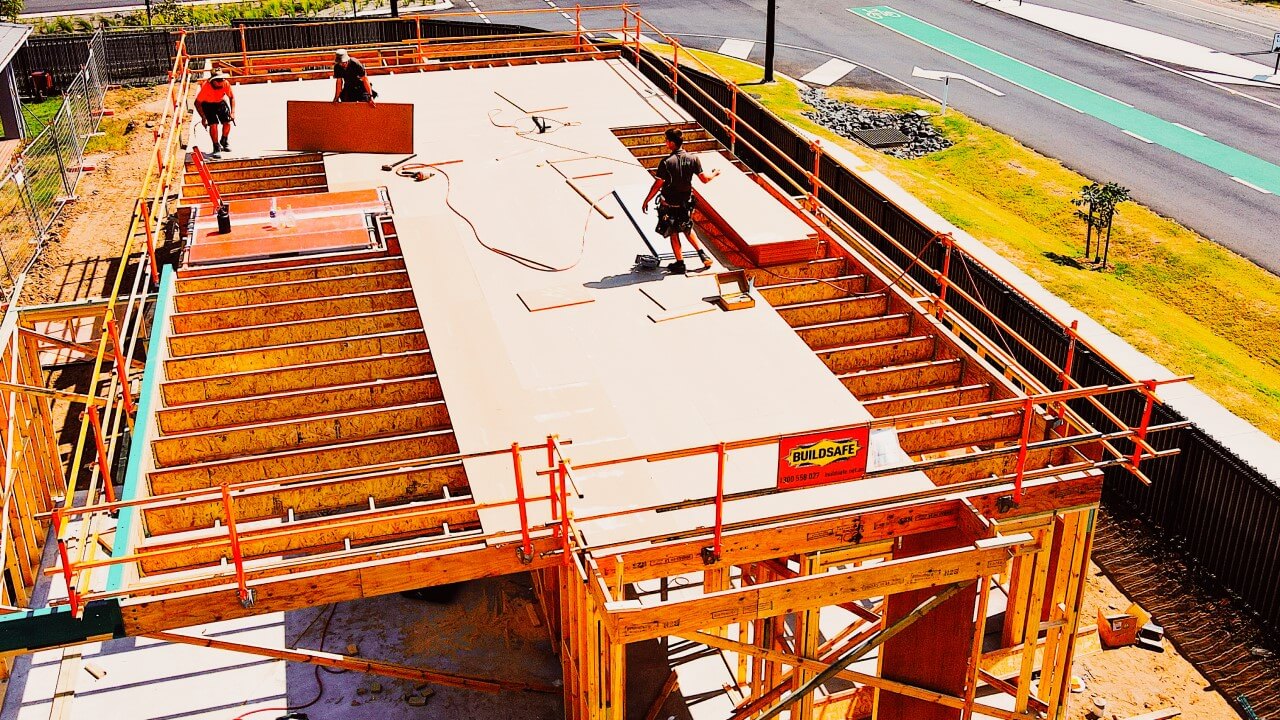
Example of temporary edge protection: Buildsafe guard
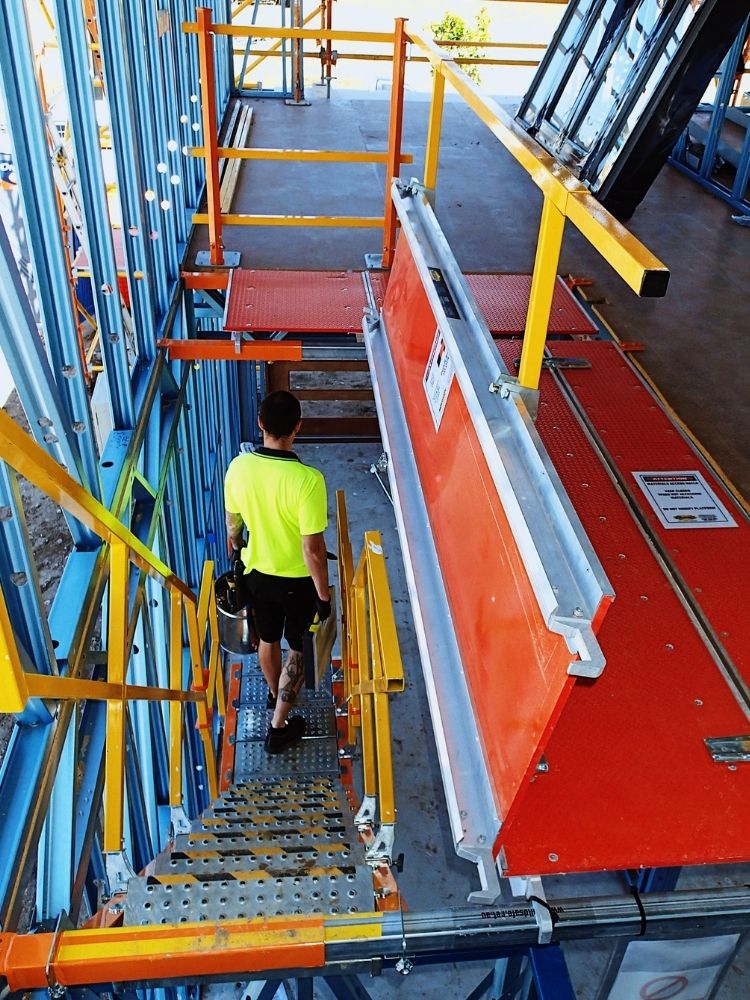
Example of temporary void and stair system: Buildsafe void platform system
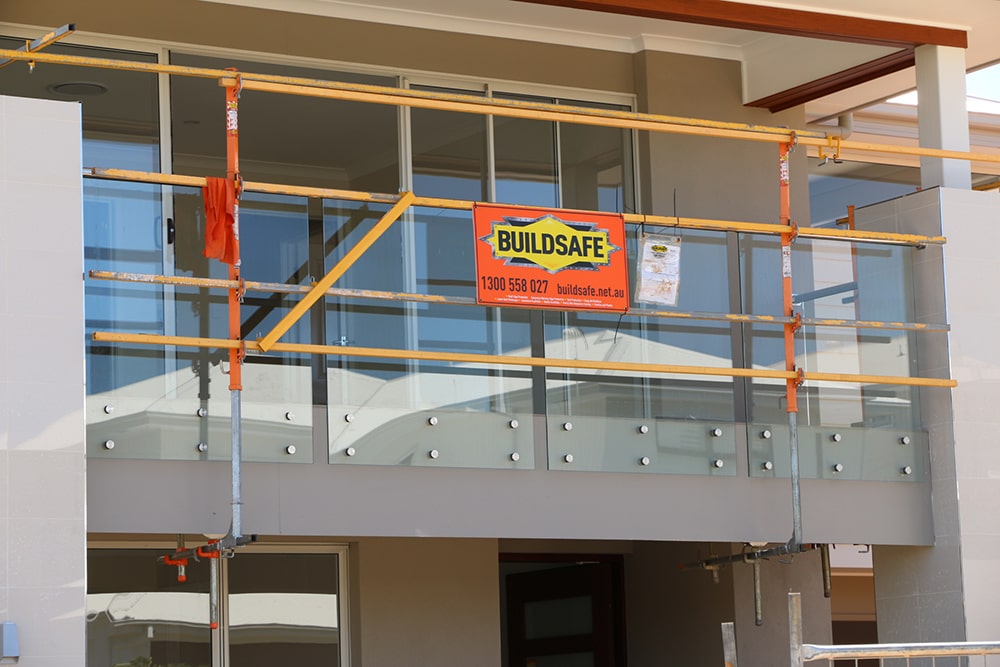
Example of balcony guard rail: Buildsafe balcony fallguard
Critical Risk Event 2: Risk of materials and objects falling
Intent: To eliminate or minimise the risks of materials or objects falling off an edge, object, structure or opening resulting in fatalities, injuries and events arising from working at height or on elevated work platforms.
Reference:
- Managing the risk of falls at workplaces Code of Practice 2021
- CB class high risk work license includes bridge and gantry cranes.
High risk activity: There is no high-risk activity for this risk event. PCBU must identify, assess, and control all hazards and risks.
Risks:
- Death (single/multiple) – worker or member of the public.
- Permanently disabling injury (physical/psychological).
Potential hazards
- Materials falling from an elevated work area.
- High wind event causes materials to fall.
- Design, installation, storage, maintenance not in accordance with engineers or manufactures design and installation requirements.
- Uncontrolled collapse of a structure, plant, or materials.
Potential controls
- Enclosure of work areas – Provide physical barriers in accordance Australian Standards to control falls from height i.e., guardrails, shade cloth or mesh.
- Tool and equipment tethers/lanyards – Use tool tethers or lanyards when working at height.
- Wind exposure – Tie down or move to safe area all objects that could topple or be blown or uplifted relocated.
- Structural alterations – Ensure temporary or permanent structures are secured. Conduct inspections of all temporary and permanent structures.
- Exclusion zones – Where tools, materials, objects, or equipment could fall erect exclusion zone around overhead work.
- Secondary protection or catch measures – Erect overhead protection where objects could fall.
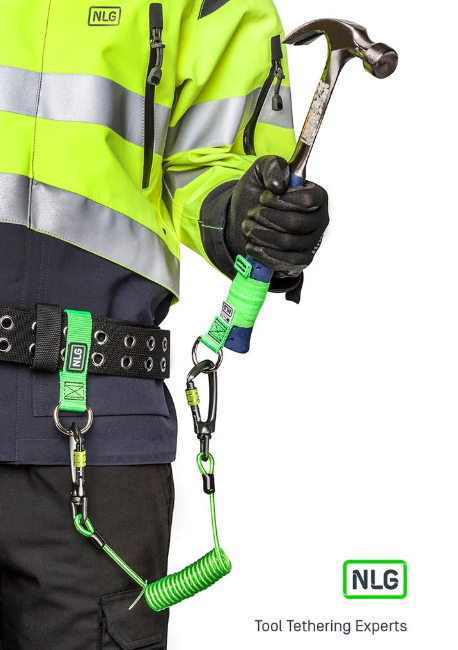
Example of tool lanyard: Never Let Go tool tethering
Critical Risk Event 3: Risk of working near vehicles and plant (work sites and public spaces)
Intent: To eliminate or minimise the risks associated with the operation and movement of vehicles and plant within construction zones and public spaces including heavy equipment, fixed and mobile plant where the adverse impacts could result in a fatality or serious injury.
Reference: Traffic management for construction or maintenance work Code of Practice 2008
High risk activity: Work in or adjacent to a road, railway, shipping lane or other traffic corridor that is in use by traffic other than pedestrians.
Risks:
- Death (single/multiple) – worker or member of the public.
- Permanently disabling injury (physical/psychological).
Potential hazards
- Lack of training leading to lack of competency, impairment e.g. speed, distractions, failure of ground or structure
- Mechanical failure e.g., fires, tyres, and brakes
- Inadequate planning e.g., lack of segregation, public transport interfaces, plant/personnel, loss of control, failure of communications or traffic control
- Sub-standard roads, weather conditions e.g., turning points, fog, unclear pedestrian/vehicle routes, unstable ground or structures, poor interface management, restricted operator vison, blind spots, poor lighting or visibility, poor road markings and obstacles
- Vehicle or equipment is unfit for purpose e.g., lack of maintenance, poor procurement, structural fatigue, exceeding the design parameters
- Third party event e.g., visitor or member of public unauthorised access to work areas, unplanned medical event, sabotage, theft and contact with other equipment
- Incorrect assembly or disassembly of temporary or permanent structures.
Potential controls
- Traffic management – Onsite and offsite traffic management for construction and haul roads and spotters (TC’s)
- Pedestrian and vehicle segregation – Provide clear separation between pedestrians, materials, and vehicles, i.e. physical barriers such as water filled plastic barriers
- Parking and traffic routes – Implement traffic management plans to avoid vehicle-to-vehicle and vehicle-to-pedestrian interaction
- Use of light vehicles on site – Implement traffic management plans for tool of trade vehicles operating in construction zones
- Use of plant, equipment and vehicles – Onsite traffic management controls for mobile plant, equipment and vehicles used for ground and civil works
- Installation, inspection, maintenance, and dismantling – Fixed and mobile plant must be installed, erected, adjusted, inspected, maintained, in accordance with the engineers and manufacturer’s requirements by qualified personnel
- Vehicle and plant recovery and rescue – Develop recovery measures for vehicles and plant immobilised or bogged.
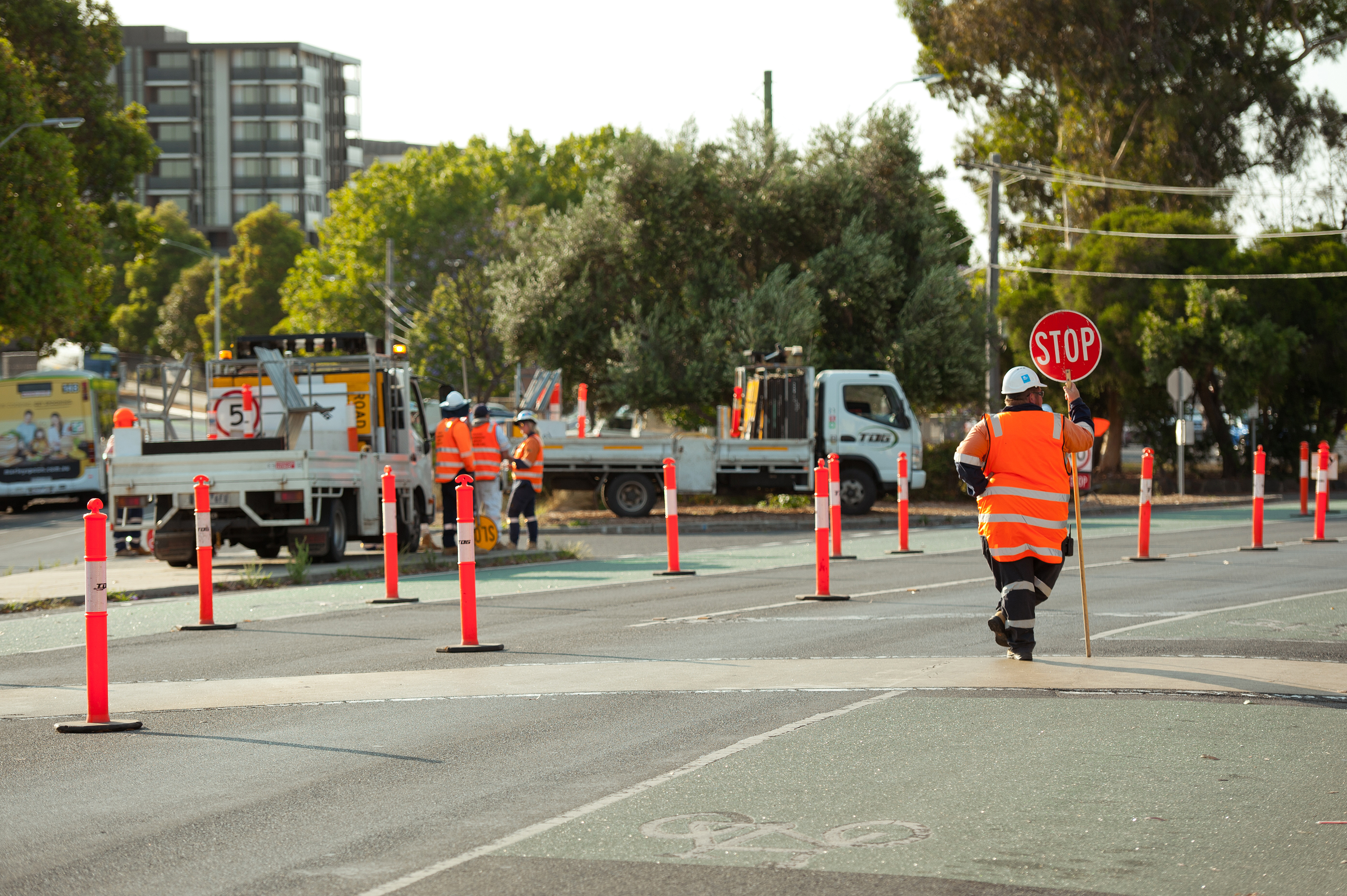
Traffic management
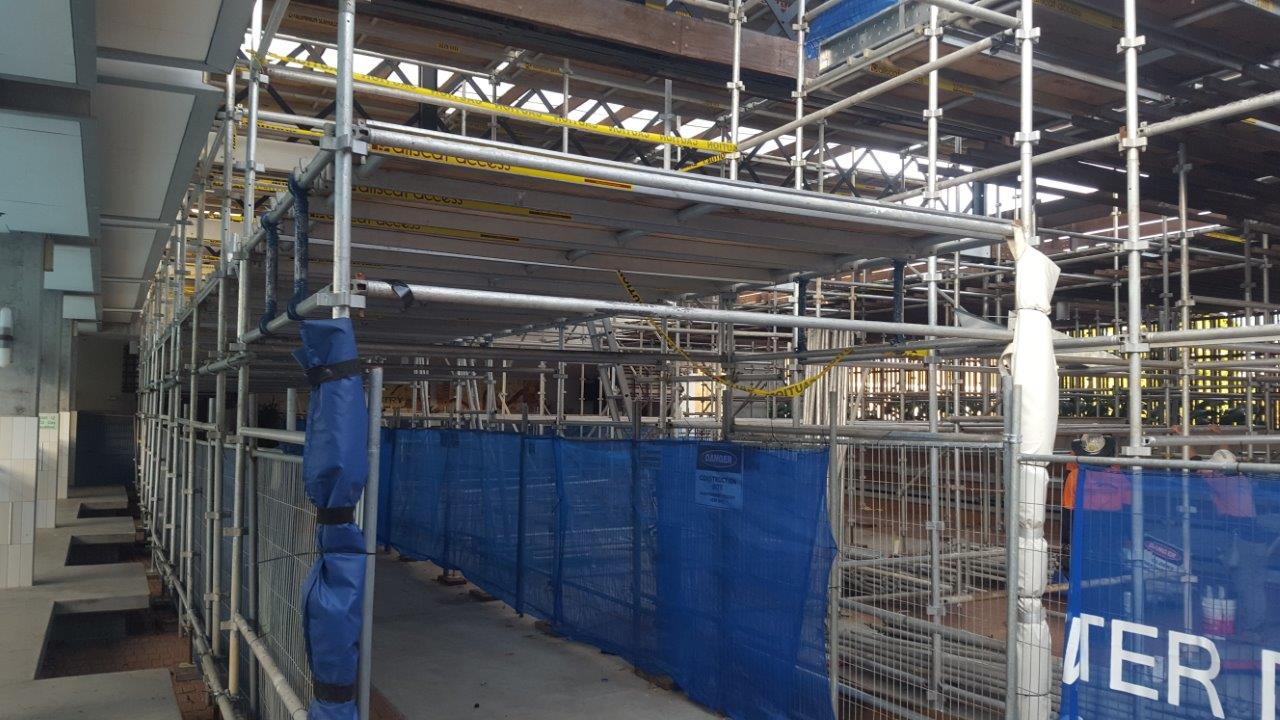
Pedestrian segregation protected walkway example: All Scaf Access
Critical Risk Event 4: Working on or near electrical energy
Intent: To eliminate or minimise the risks associated with the uncontrolled release of electrical energy from high voltage (HV) and low voltage (LV) electrical work where there is the risk of a fatality or serious injury from a person being electrocuted or burned by the uncontrolled release of electrical energy.
Reference:
- Electrical Safety Code of Practice 2020 – Working near overhead and underground electric lines
- Managing electrical risks in the workplace Code of Practice 2021
- Electrical Safety Code of Practice 2020 – Electrical equipment rural industry
High risk activity: Work on or near energised electrical installations or services.
Risks:
- Death (single/multiple) – worker or member of the public.
- Permanently disabling injury (physical/psychological).
Potential hazards
- Unintentional contact with or proximity to live exposed electrical source – HV or LV
- Unintentional contact with or proximity to live overhead power lines
- Unintentional contact with or proximity to live buried electrical services
- Unintentional contact with electricity by a qualified electrician when performing work on known live electrical services
- Power tools not tested and tagged, in poor condition, not maintained.
Potential controls
- Identification and schematics – All electrical circuits, fixed and construction wiring, including overhead/underground services are identified and recorded
- Appropriate electrical equipment – All electrical equipment including insulated mobile elevated work platforms (MEWPs), tools and personal protective equipment (PPE) must be fit for purpose and compliant. Test and tag electrical tools 3 monthly
- Electrical supply – Construction electrical supply boards must locate near work areas to minimise trailing cables. Permanent and temporary power sources must be secured to prevent unauthorised access
- Isolation – De-energise, isolate, test and prove for dead prior to any work on electrically powered items
- Live work – Live work is authorised, planned, and communicated and prohibits lone working
- Fault finding – When investigating any electrical equipment identify and rectify faults. All items must be treated as live until the fault is located
- Overhead conductors – Prevent inadvertent overhead services contact by equipment or operational activity
- Underground services – Prior to ground disturbance, underground electrical services must be positively located with work planned accordingly.
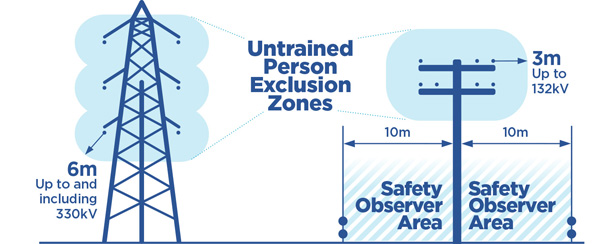
Energy exclusion zones example from Energex
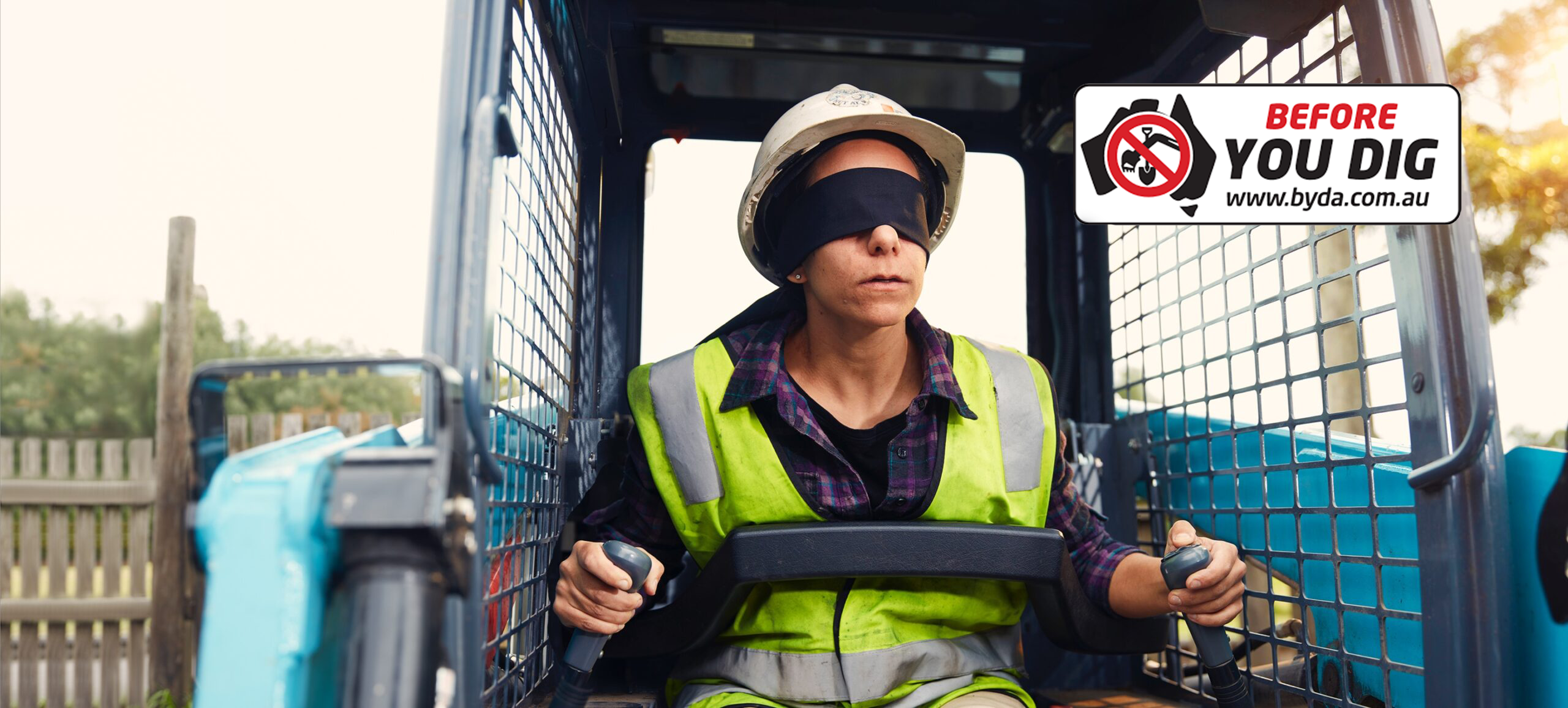
Critical Risk Event 5: Fire and explosion
Intent: To eliminate or minimise the risks associated work where the treat of fire from hot works such as grinding or cutting, welding or oxy cutting or the heat from engines and exhausts, is a risk that may result in the fatality of one or more people.
Reference: Managing risks of hazardous chemicals in the workplace Code of Practice 2021
High risk activity: Work in an area that may have a contaminated or flammable atmosphere.
Risks:
- Death (single/multiple) – worker or member of the public.
- Permanently disabling injury (physical/psychological).
Potential hazards
- Plant, equipment, or vehicle on fire due to inadequate maintenance, improper use or being unfit for purpose.
- Unsafe and non-compliant hot works
- Ignition of flammable materials >5% LEL e.g. gas, liquid or solids
- Self-combustion of gases, chemicals
- Unplanned sudden release of stored flammable materials
- Failure of component or system
- Frictional ignition from equipment
- Unauthorised smoking and other open flame ignition sources
- Unsafe re-fueling activities
- Utilities, electrical system, or cable overheating
- Poor housekeeping and unsafe storage of combustible materials
- Intentional or un-intentional third-party activities
- Adverse weather conditions.
Potential controls
- Prioritisation of non-combustible materials – Substitute or minimise use of combustible materials with non-combustible or lowest combustible materials wherever possible
- Ignition sources – Eliminate ignition sources
- Inspection and maintenance – Inspect and maintain fire monitoring and mitigation systems and equipment
- Hot work – Permits to work must be in place for all hot works activities
- Refuelling equipment – Controlled refuelling areas and procedures for refuelling large equipment, plant, machinery, and vehicles
- Excavations and tunnelling – Geotechnical investigations must identify gas or trapped hydrocarbons
- Means of escape – Provide clear means of escape.

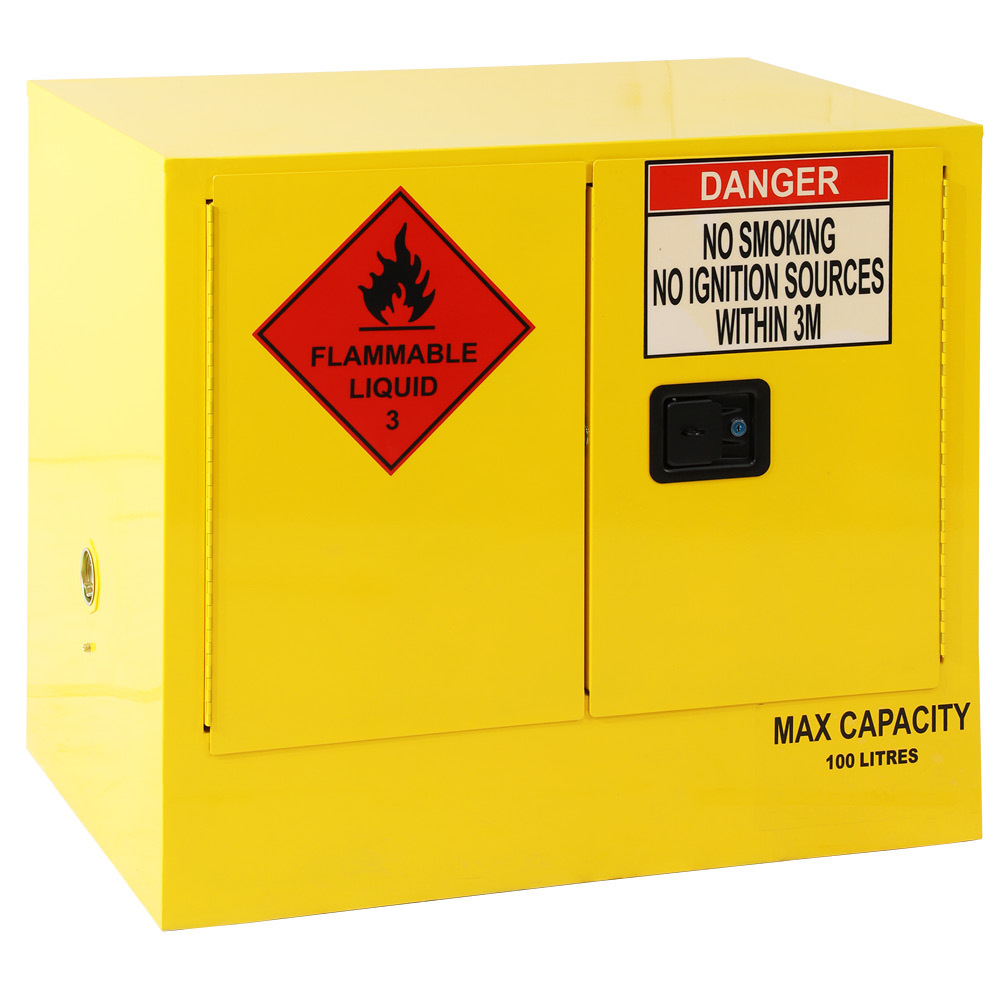
Fire extinguisher and chemical storage
Critical Risk Event 6: Crane and hoisting equipment
Intent: To eliminate or minimise the risks associated all activities where loads are raised and lowered by tower and mobile cranes, barge cranes, recovery cranes, material and passenger hoists, gantry cranes, hoisting with excavators, gin poles (telecommunication tower erection), forklifts and telehandler type material lifting equipment where a failure of the equipment or operation could result in a fatality or other injuries.
Reference:
- Mobile crane Code of Practice 2024
- Tower crane Code of Practice 2017
- CB class high risk work licence includes bridge and gantry cranes
- Safe Work Australia Bridge and Gantry Crane Information Sheet
High risk activity: Work in an area at a workplace in which there is any movement of powered mobile plant.
Risks:
- Death (single/multiple) – worker or member of the public.
- Permanently disabling injury (physical/psychological).
Potential hazards
- Failure of, foundation, or supports (crane tower or mobile crane)
- Crane and lifting equipment overload due poor planning
- Crane and lifting equipment collision e.g. jibs
- Improper assembly or disassembly of plant or equipment
- Crane and lifting equipment used incorrectly or not to standard e.g. insufficient locks and limit devices
- Adverse conditions (e.g. storms, slopes, ground conditions
- Plant and equipment misuse or lack of competence
- Operator fatigue or impairment
- Equipment not maintained
- Impact from other plant or equipment
- Fire on crane and lifting equipment
- Overload of structures
- Sabotage.
Potential controls
- Cranes and hoisting equipment in use – Only use lifting and hoisting equipment suitable for the operation
- Lift plans – Prepare lift plans for two crane lifts
- Installation, Inspection, maintenance, and dismantling – Cranes and other hoisting equipment must be installed, erected, adjusted, inspected, maintained, and dismantled in accordance with the manufacturer’s requirements
- Tower crane access and security – Install anti-climb barriers to crane towners
- Ground conditions – All cranes must be established and set up on approved ground conditions
- Fatigue management – Implement a fatigue management program
- Preventing plant collisions – Implement traffic management plans
- Handling objects – Uncontrolled movement of objects must not occur
- Movement of cranes – Audible alarms, anti-collision devices, deceleration devices to slow the bridge or gantry crane down, signage.
Critical Risk Event 7: Movement of power mobile plant and equipment
Intent: To eliminate or minimise the risks associated with working around mobile plant and equipment on construction sites where people could be fatality injured due to encountering mobile plant and equipment.
Reference: Managing the risks of plant in the workplace Code of Practice 2021
High risk activity: Work in an area at a workplace in which there is any movement of powered mobile plant.
Risks:
- Death (single/multiple) – worker or member of the public.
- Permanently disabling injury (physical/psychological).
Potential hazards
- Mechanical failure e.g. hydraulic
- Not fitting guarding or bypassing interlocks.
- Equipment is unfit for purpose e.g. lack of or irregular maintenance, inadequate guarding or interlocking
- Inadequate planning e.g. poor instructions on safe use and lack of segregation
- Operator error e.g. competency and/or fatigue, failure to perform bump test on earthmoving equipment attachments
- Uncontrolled release of stored energy
- Failure of quick release couplers and safety pin not engaged.
Potential controls
- Guarding – Ensure machine guarding is fitted and in good working order
- Preventing Access – Appropriate physical and non-physical barriers must be in place to prevent access to specific areas with mobile plant and equipment and maintenance activities are being undertaken. i.e. Spotters/TC’s
- Mobile equipment maintenance – Implement and monitor appropriate maintenance in accordance with manufactures maintenance procedures
- Emergency stops – Ensure equipment equipped with emergency stops are operational
- Fit fully automatic quick hitches and conduct bump test on attachments.
Critical Risk Event 8: Failure of structures load bearing and non-loadbearing (temporary or permanent)
Intent: To eliminate or minimise the risks associated with structural failure of temporary and permanent load bearing and non-load bearing structures (access gates, scaffolding, formwork, fencing, concrete, demolition work or structural steel that may result in serious injury or fatality to workers and members of the public.
Reference:
High risk activity:
- Demolition of an element of a structure that is loadbearing or otherwise related to the physical integrity of the structure.
- Structural alterations or repairs that require temporary support to prevent collapse.
Risks:
- Death (single/multiple) – worker or member of the public.
- Permanently disabling injury (physical/psychological).
Potential hazards
- Inadequate design relating to ground stability, foundations, and structure
- Inadequate construction, workmanship and installation e.g. overloading, incorrect sequencing, not following design or unauthorised alteration
- Impact by third party activities e.g. struck by vehicle or plant, third party activities, weather affecting ground stability or leading to the undermining or erosion of adjacent ground and sabotage
- Inadequate maintenance, inspection, and testing, including stability of permanent structures supporting the temporary works
- Lack of operator experience.
Potential controls
- High risk work licencing – Ensure persons have the appropriate high-risk work licences. Ensure workers erecting formwork, fencing and permanent and temporary structures are trained and competent
- Structural Integrity – Ensure designers have documented design requirements for permanent and non-permanent structures including methods for adjusting temporary and permanent structures
- Installation – The installation of structural elements must be subject to quality management rigour and certification
- Exclusion Zones/Overhead Protection – An adequate exclusion zone or overhead protection must be in place for demolition works or any other controlled method of structural deconstruction where there is a risk of structural collapse beyond the applicable area.
Critical Risk Event 9: Excavations, trenches, and stockpile collapse
Intent: To eliminate or minimise the risks associated working around shafts, trenches and stockpiles of earth and materials.
Reference: Excavation work Code of Practice 2021
High risk activity: Work in or near a shaft or trench with an excavated depth greater than 1.5 metres
Risks:
- Death (single/multiple) – worker or member of the public
- Permanently disabling injury (physical/psychological).
Potential hazards
- Unsafe work methods e.g. poor sequencing, failure of temporary or permanent support and stocks unsafe
- Ground or spoil movement due to vibration from vehicles, adjacent work activities
- Adverse weather and natural disasters, including water ingress
- Unexpected ground conditions e.g. voids, ground or water pressure
- Inadequate design, procurement, maintenance and lack of inspections of excavations, trenches and stockpile, failure or incorrect installation of benching, battering or shoring
- Lack of training, skills and competency of workers and frontline leaders.
Potential controls
- Ground Conditions – Excavations and stockpiles must be managed in accordance geological conditions. Inspect trenches, excavations, and stockpile before entering for stability
- Excavation and Stockpile Management – Consider safe angles, access, and structural integrity of trenches, excavations, and stockpiles
- Check stockpiles daily, especially after significant weather conditions (long term sun and heavy rain)
- Rollover Protection and Falling Object Protective Structure – Rollover Protection Structure (ROPS) on plant and equipment
- Emergency Response – Provide an effective local emergency response capability.
Critical Risk Event 10: Occupational health (dusts – asbestos, respirable crystalline silica (RCS), fumes, and vapours, high temperatures and humidity)
Intent: To eliminate or minimise the risks associated occupational exposure to hazardous substances, asbestos, diesel particulates, respirable dusts such as silica, noise, vibration, extreme temperatures, flora, fauna, or allergens that could realistically result in the death of one or more people.
Reference:
- How to safely remove asbestos Code of Practice 2021
- How to manage and control asbestos in the workplace Code of Practice 2021
- Managing respirable crystalline silica dust exposure in construction and manufacturing of construction elements Code of Practice 2022
- Managing respirable crystalline silica dust exposure in the stone benchtop industry Code of Practice 2019
- Managing risks of hazardous chemicals in the workplace Code of Practice 2021
- Managing the work environment and facilities Code of Practice 2021
High risk activity: Work in an area that may have a contaminated or flammable atmosphere.
Risks:
- Death (single/multiple) – worker or member of the public
- Permanently disabling injury (physical/psychological).
Potential hazards
- Exposure to identified or unidentified hazardous substances
- Ineffective management of known hazardous substances
- Existing structures containing asbestos and other hazardous materials are disturbed during inspection, maintenance, cleaning, demolition, or renovation
- Asbestos air monitoring is ineffective
- Contact with flora or fauna e.g., toxic flora, spiders, snakes, fire ants, dogs, urine, or faecal matter
- Clothing or PPE is inappropriate or not used during exposure whilst working
- Level and duration of exposure to natural/artificial temperatures including unexpected temperature changes
- Excessive physical activity and duration
- Pre-existing illness or medical conditions
- Failure of cooling, heating, or ventilation systems
- Insufficient consumption of water and food
- Falling elements (e.g. trees or tree limbs)
Potential controls
- Asbestos register and removal plan - Licenced asbestos removalist must obtain the asbestos register. Licenced asbestos removalist must prepare an asbestos removal plan. Licensed asbestos removalist must complete a clearance inspection/certificate
- Health monitoring – Refer to Codes of Practice
- Air monitoring – Refer to Codes of Practice
- Extreme temperatures or humidity –Consider rest breaks, adequate supplies of drinking water, sun protection, shaded areas
- Interaction with flora, fauna and allergens – Provide snake bite kits, treatment for bites and stings, Poison Information Centre 13 11 26
- Exposure to hazardous substances – Provide SDS for all hazardous substances. Complete a hazardous chemical register
- Hazardous substance storage – Refer to a hazardous substance compatibility chart to ensure non-compatible substances are stored correctly. Minimise the number of hazardous substances on the project. Store hazardous substances in approved storage cupboards.
Risk Assessment and Safe Work Method Statement Consultation
These 10 critical risk events and controls can be used to assist in the development of risk assessments (RA) and safe work method statements (SWMS).
The PCBU must consult with workers when preparing RAs and SWMS. Consultation must also occur when new equipment is introduced into the workplace or when new hazards and risks are identified.
As a PCBU you must consult with workers when:
- identifying hazards and assessing risks to health and safety arising from the work carried out or to be carried out
- making decisions about ways to eliminate or minimise those risks
- making decisions about the adequacy of facilities for the welfare of workers
- proposing changes that may affect the health or safety of your workers
- making decisions about procedures for consulting with workers; resolving health or safety issues at the workplace; monitoring health of your workers; monitoring the conditions at the workplace under your management or control and providing information and training for your workers.
There may be other matters that a PCBU must discuss with workers.





